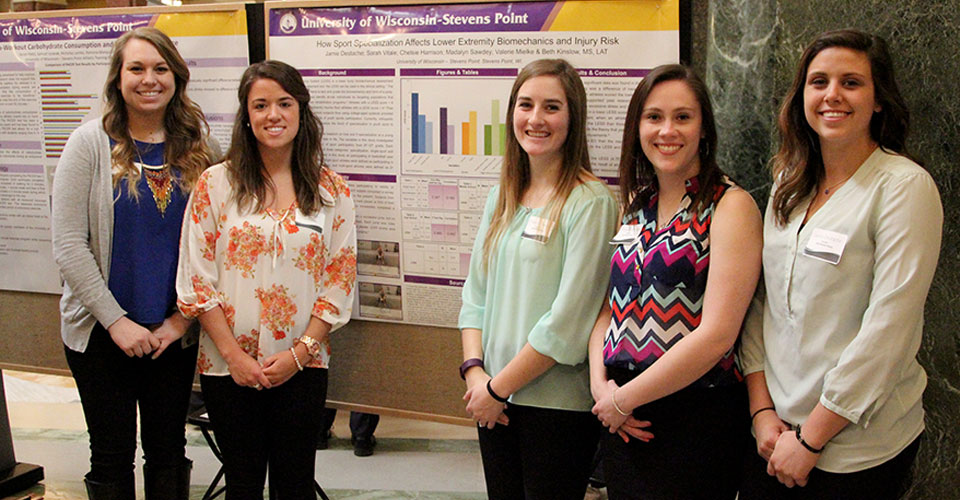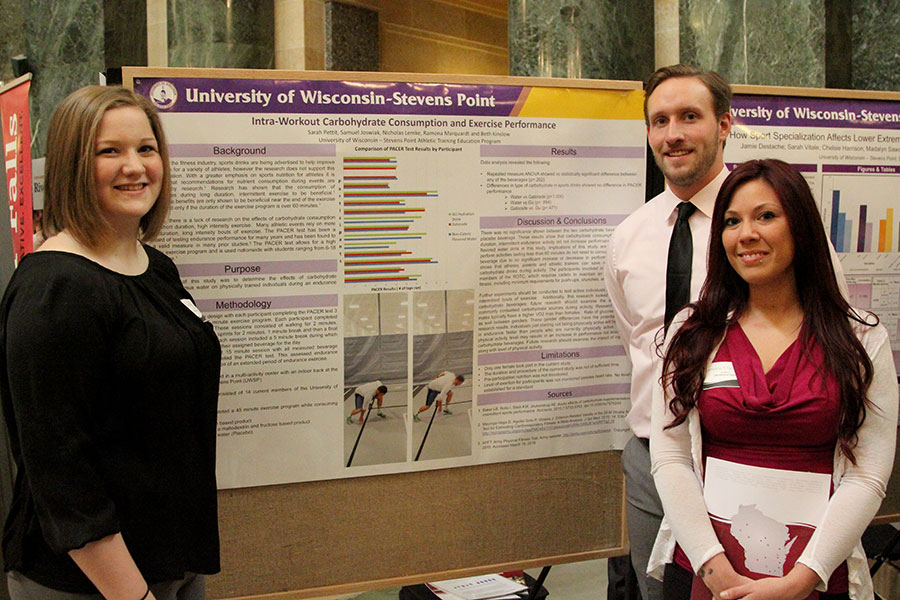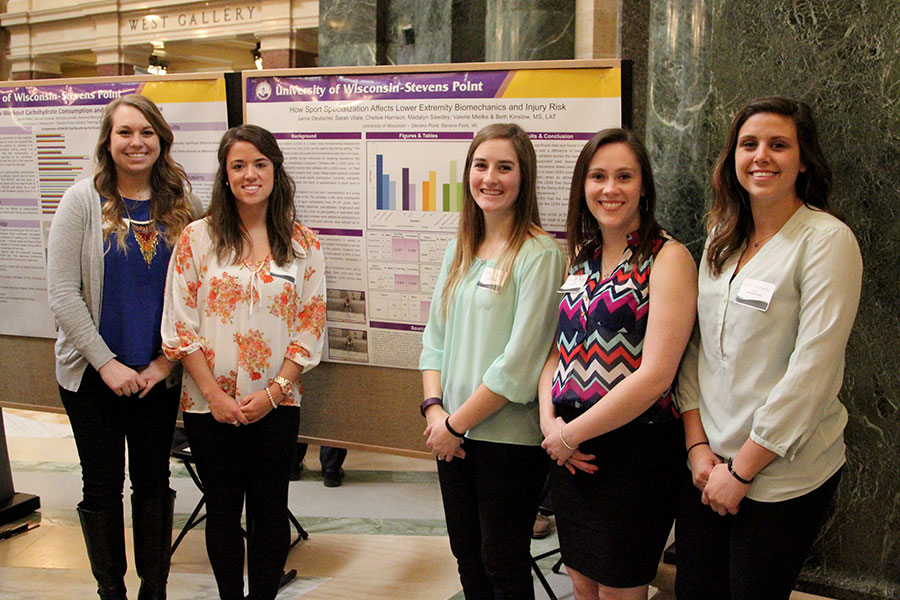
Athletic training students from the University of Wisconsin-Stevens Point shared research findings during the 13th annual Posters in the Rotunda event Wednesday, April 13, at the State Capitol in Madison. [Photo Gallery]
Each year, Posters in the Rotunda is a wonderful opportunity to learn about the exciting research going on throughout the state and to support Wisconsin students and faculty members who contribute to the state’s strong economic future.
The University of Wisconsin System is a national leader in undergraduate research, which contributes to the state’s priorities, including retention, graduate rates, workforce and economic development.
 Senior athletic training majors Sarah Pettit, Samuel Joswiak, Ramona Marquardt and Nick Lemke (not pictured) worked in a research group that studied the effects of carbohydrate consumption versus water for athletes in endurance tests. The group’s adviser was Associate Lecturer Beth Kinslow.
Senior athletic training majors Sarah Pettit, Samuel Joswiak, Ramona Marquardt and Nick Lemke (not pictured) worked in a research group that studied the effects of carbohydrate consumption versus water for athletes in endurance tests. The group’s adviser was Associate Lecturer Beth Kinslow.
“Do You Need More Than Water During Your Workout? An Examination of Intra-workout Carbohydrate Consumption and Exercise Performance”
Context: Currently in the media, orthopedic surgeons are advocating to de-emphasize the trend of specialization in sport to decrease risk factors related to injury. Objective: This proposed research is to discover how sport participation, both past and current, affects lower extremity biomechanics in athletes using the Landing Error Scoring System (LESS). Specifically, the focus will be to compare the results of the LESS scores between multi-sport athletes (playing more than one sport for 5+ consecutive years), single-sport athletes (playing one sport or less for 2 consecutive years) and specialized athletes (5 non-consecutive years of year round basketball). Setting: Testing was performed in a gymnasium on Division III college-aged students with focus on their youth sport participation. Patients or Other Participants: Participants are current members of the University of Wisconsin-Stevens Point (UWSP) men’s and women’s intercollegiate basketball teams and members of the UWSP men’s and women’s intramural basketball program. Ages range from 18-25. Interventions: Participants will complete an intake questionnaire to determine sport participation and training methods from 6th grade to the present. Each participant will be videotaped completing a jumping protocol which will then be evaluated based on the 17 pre-determined criteria of the LESS. The tool used, LESS, is valid and reliable in assessing high-risk movement patterns and detecting poor biomechanics. This tool has a high interrater and interrater reliability. Main Outcome Measures: Using the SPSS system, a .05 p-value was used to run correlations, Independent Samples T-tests, and one-way ANOVAs looking at the following variables; multi-sport(MS) versus single sport(SS) versus specialization(SP), male versus female, and recreational versus intercollegiate. Results: Statistics for MS, SS and SP: One way ANOVA: (p=.347), Correlation: (p=.169), Difference of means: (SS=6.00, MS=4.82, SP=5.10) Statistics for gender: Correlation: (p=.388) T-test: (p=.365) Difference of means: (Female=4.83, Male=5.29) Statistics for level of participation: Correlation: (p=.180) T-test: (p=.110) Difference of means: (Recreational=5.41, Intercollegiate=4.70) Conclusions: Due to our limited power, there is no statistically significant data found in relation to the variables tested. However, there was a difference between mean LESS scores and sport participation, mean LESS scores and gender, and mean LESS scores and level of participation. Clinical Applications: The results of the LESS score determined if the participant had high-risk movement patterns that may pre-dispose them to injury. This information could prove helpful to increasing awareness of the effects of sport specialization at a young age and the potential effects on injury risk.
- Pauda DA, Marshall SW, Boling MC, Thigpen CA, Garett Jr. WE, Beutler AI. The landing error scoring system (LESS) is a valid and reliable clinical assessment tool of jump-landing biomechanics: the jump-acl study. J. Sports Med. 2009; 37(10).
- Markbreiter J, Sagon B, Valovich McLeod T, Welch C. Reliability of clinician scoring of the landing error scoring system to assess jump-landing movement patterns. J Sport Rehabil. May 2015;24(2):214-218.

